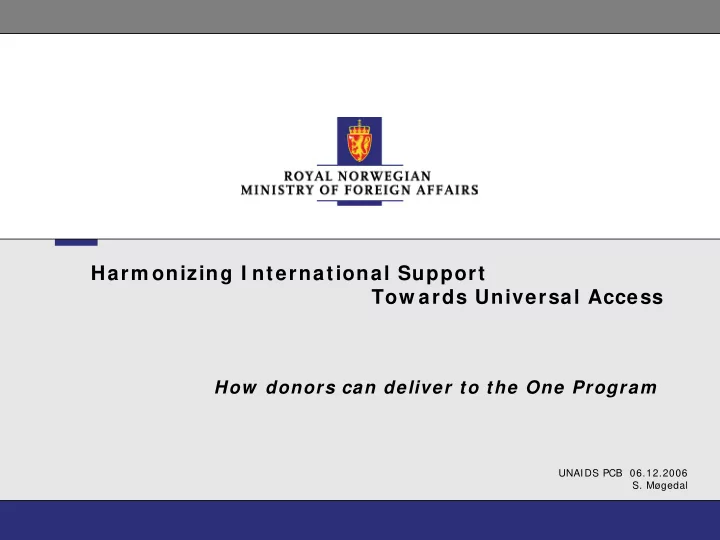

Harm onizing I nternational Support Tow ards Universal Access How donors can deliver to the One Program UNAIDS PCB 06.12.2006 S. Møgedal
International support – who are the donors? • Donors are a diverse group of public and non-state partners, but largely public support • The sam e group of OECD donors are engaged in multiple ways of providing support (surprisingly non- coherent) • International non governm ental organizations who act as donors does to a large extent also receive public funds in addition to funds raised • Multilateral financial support through the UN is a combination of assessed and voluntary contributions from member countries (public) • Financial support through the MDB/ I FI is also based on public finance from shareholders • Private sector works trough foundations, donations and corporate social responsibility + i n kind contributions (technical or material - have limitations) 2
Value basis: Value basis Universal Equity Shared interest access External policy YOUTH Health workers environment. TRADE. TRIPS. Procurement TB/AIDS Personnel Net- Information as basis Research PMTCT works for setting priorities OVC Basic needs Multilateral actors and for following results Industry SRHR Knowledge HBC Advocacy Bilateral actors Basic services Demand e a t s t n - o N Rights G Coping l o r b e a d l n r s o e c t a G I n i Information t i a t i v e s National budget Organization Regional actors National priorities Democratic oversight Political basis At centre: PLWHA Empowered civil society Regional og Global National ownership leadership POLITICAL LEADERSHIP 3
What are critical bottlenecks? 1 . Blurred boundaries makes alignment a theoretical issue 2 . Diverse Perceptions of Realities – the need for constructing a shared reality 3 . Unpredictable domestic and external finance 4 . Lack of Fit , Financing Instruments 5. Human Resource Shortages ( critical capacity ) 6 . Overloaded Procurem ent Systems further fragmented by donor approaches 7 . Governance issues – donors impact on the capacity for inclusive management of diversity – representation, transparency, accountability 8. Donor processes are in a developm ent m ode , not an emergency mode Civil society, PLWHA networks and households not included in mainstream donor dialogue on “effective aid” 4
Blurred boundaries and lack of focus The boundaries for the One Framework are 1. necessarily interw oven w ith developm ent , but the “constituencies” do not link up The One Framework can accommodate any external 2. contribution – lack of focus The One Framework does not “ speak to pow er ” in 3. ways that confront and call for necessary system change Dealing with gaps: No agreement/ compact on shared 4. responsibility and mutual accountability for meeting the bottom line Diverse Perceptions of Realities Different views on the nature, size and impact of the 1. epidemic among country actors, including donor partners Too much or too little available finance for HIV and 2. AIDS? 5
Domestic and External Finance 1. Unpredictable and insufficient dom estic allocations ; lack of clarity in the budget structure for finance towards The One Framework (Health/ AIDS; Multi-sector/ AIDS) - issues of fungibility 2 . I ncom plete inform ation about external resource flows (off budget/ on budget discussion; NGO finance etc) 3. Finance towards the fully costed One Framework should reflect in-country “standard”expenditure (including value of standard drugs), with agreement about how to factor in “cost to donor” 4. The need for multi-year commitments. Making a multi- partner deal around the “bottom line” W atch risks ! 5. Finding the m atch between flexible funding and earmarked funding rather than arguing that all funding should be the same. 6
Lack of “fit”, Financing Instruments GFATM funding for HIV and AIDS needs to be 1 . discussed in relation to the total funding of the One Framework; ie need an arena for making the fit which is better informed PEPFAR funding and other project funding in a 2 . similar way need to be related to the total cost and the need for matching the “bottom line” NGO funding needs to ensure complementarity and 3 . arrangements for broad inclusion as well as linking up Basket and budget funding need to be followed 4 . with indicators that demonstrate consistency and predictability in allocations to AIDS and critical sectors for universal access (ref health) 7
Human Resource Shortages; Health Workers 1. An urgent need for bringing all partners together ( Country Action Team s ) to establish common reality and deal with bottom line issues • public sector partners • NGO partners • professional associations, academic institutions, private sector 2 . PE/ GDP ratio as a focus for political commitment 3. Fair and “accountable” com petition for scarce resources as a focus for international partners – need accountability mechanisms for shared responsibility 4. Distribution and Retention. Salary and work place issues, and overcoming public/ private barriers, gaps and overlap. “Package” response to bottom line needs 5. Alternative service providers/ linking up and allow ing diversity . Inclusion PLWHA with fair remuneration 6 . Training of skilled workers 7. “Poach one – train three” – compensation arrangements 8. Global and regional issues of m igration (brain circulation and brain drain) 8
What are critical bottlenecks? 1 . Blurred boundaries makes alignment a theoretical issue 2 . Diverse Perceptions of Realities – the need for constructing a shared reality 3 . Unpredictable domestic and external finance 4 . Lack of Fit , Financing Instruments 5. Human Resource Shortages ( critical capacity ) 6 . Overloaded Procurem ent Systems further fragmented by donor approaches 7 . Governance issues – donors impact on the capacity for inclusive management of diversity – representation, transparency, accountability 8. Donor processes are in a developm ent m ode , not an emergency mode Civil society, PLWHA networks and households not included in mainstream donor dialogue on “effective aid” 9
Recommend
More recommend